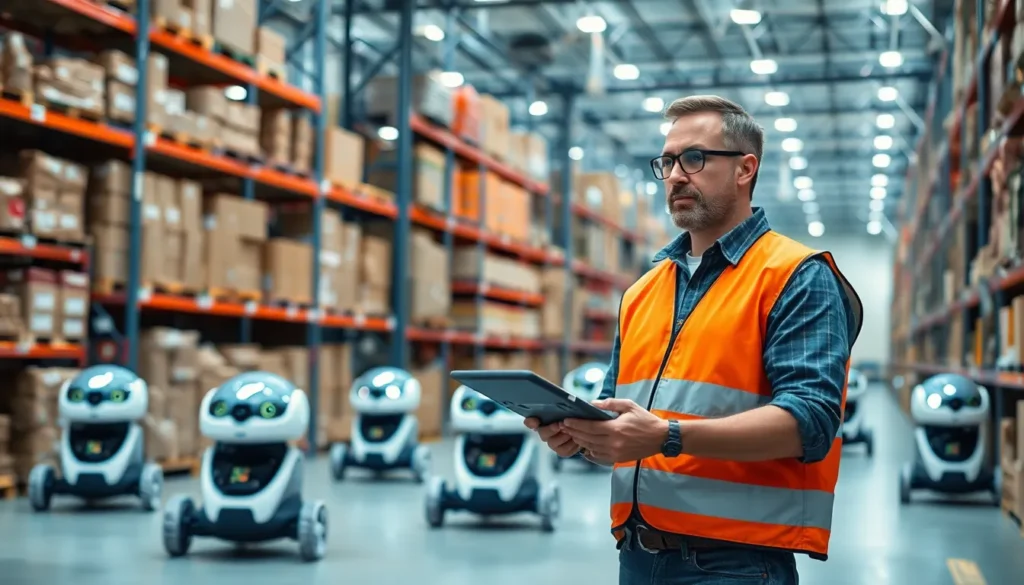Imagine a world where robots handle the heavy lifting while humans sip coffee and strategize from the comfort of their desks. Welcome to fleet robotics, where efficiency meets innovation in the most delightful way. These mechanical marvels aren’t just future tech; they’re transforming industries today, streamlining operations, and reducing costs faster than you can say “robot uprising.”
From warehouses to delivery services, fleet robotics is revolutionizing how businesses operate. These tireless workers don’t take coffee breaks or complain about the weather. Instead, they work around the clock, ensuring everything runs smoothly and efficiently. As companies embrace this technology, they’re not just keeping up with the competition; they’re leaping ahead. Buckle up—it’s time to explore how fleet robotics is changing the game and why it’s the smart choice for any forward-thinking organization.
Table of Contents
ToggleOverview of Fleet Robotics
Fleet robotics represents a significant advancement in automation technology, focusing on the coordination of multiple robots to perform tasks efficiently. Companies utilize this technology to streamline operations and increase output. With the ability to operate continuously, these robots enhance productivity, particularly in environments such as warehouses and logistics centers.
Robots in fleet operations often communicate with one another, sharing information on tasks and obstacles, which optimizes their performance. Autonomous mobile robots (AMRs) serve as a prime example, navigating complex environments and transporting goods without human intervention. Deployment of these robots often leads to substantial reductions in labor costs.
Industry leaders have reported that integrating fleet robotics can decrease operational delays. They achieve this by automating routine tasks like sorting and transporting items. Fleet robotics also helps improve accuracy in inventory management, reducing discrepancies that arise from manual tracking.
Notably, the technology adapts to various operational needs. Some fleets consist of robots designed for specific tasks, while others involve multi-functional units capable of handling diverse jobs. This flexibility supports a wide range of industries, from manufacturing to healthcare.
Several studies indicate that companies adopting fleet robotics experience increased scalability. They can easily expand their operations by integrating additional robots, making it feasible to meet growing demands. Organizations leverage these systems as part of their strategic initiatives, ultimately leading to enhanced competitiveness in their respective markets.
Benefits of Fleet Robotics

Fleet robotics offers significant advantages that enhance operational capabilities and overall performance. Notably, this technology streamlines processes, allowing organizations to leverage multiple automated systems effectively.
Increased Efficiency
Increased efficiency stands out as one of the primary benefits of fleet robotics. Robots coordinate seamlessly while executing tasks, which accelerates workflow in environments like warehouses. Communication between robots eliminates bottlenecks, allowing for rapid sorting and transportation of goods. Organizations using fleet robotics achieve higher throughput and precise tracking of inventory. Enhanced performance reduces time wasted on manual operations, resulting in a smoother operational flow. Consequently, businesses enjoy a faster response to market demands, helping them stay competitive in dynamic landscapes.
Cost Savings
Cost savings emerge as another pivotal advantage of fleet robotics. Automated systems significantly reduce labor expenses by minimizing the reliance on human workforce for repetitive tasks. Companies also experience lower operational costs due to decreased errors and minimized delays in processes. Fleet robotics streamlines inventory management, which cuts down on losses associated with overstock and stockouts. Furthermore, robots operate continuously without the need for breaks, maximizing productivity throughout operational hours. With these financial benefits, organizations can allocate resources more strategically, enhancing overall profit margins.
Applications of Fleet Robotics
Fleet robotics has broad applications across various industries, significantly enhancing operational efficiency.
Warehousing and Logistics
Robots in warehousing and logistics streamline operations through task automation. Autonomous Mobile Robots (AMRs) transport goods, manage inventory, and optimize sorting processes. Effective communication among robots leads to synchronized workflows, reducing delays and minimizing operational bottlenecks. A 2022 study revealed that companies employing fleet robotics achieved a 30% increase in overall throughput. Notably, these robots operate continuously, which allows warehouses to maximize productivity levels over extended periods. Enhanced accuracy in inventory management also results from reduced human error, fostering trust in stock levels and aiding timely order fulfillment.
Agriculture
In agriculture, fleet robotics revolutionizes farming practices. Autonomous robots perform tasks like planting, harvesting, and monitoring crop health, which maximizes efficiency. Data-driven insights enable farmers to make informed decisions, improving yield quality. Collaborative fleets of robots handle multiple functions simultaneously, reducing the need for manual labor. According to recent research, agricultural operations using fleet robots can increase efficiency by up to 25%. Furthermore, these robots can operate in diverse weather conditions, ensuring consistent productivity regardless of external circumstances.
Transportation
Transportation sectors leverage fleet robotics to enhance delivery services. Drones and autonomous ground vehicles navigate routes efficiently while reducing delivery times. Fleet management software optimizes vehicle usage, tracking performance metrics in real time. A report indicated that companies deploying robotic delivery services reported a 40% reduction in transit times. Safety also improves, as autonomous vehicles reduce risks associated with human errors. Fleet robotics enables a more connected and responsive transportation network, yielding better service for customers and increasing company profitability.
Challenges in Implementing Fleet Robotics
Implementing fleet robotics poses significant challenges that organizations must navigate. Addressing these obstacles ensures successful integration and effective operation.
Technical Limitations
Technical limitations frequently hinder the deployment of fleet robotics. Connectivity issues can arise when robots are unable to communicate seamlessly, impacting operational efficiency. Navigation difficulties may also occur in complex environments, leading to potential delays. Battery life presents another constraint, as robots must operate for extended periods without frequent recharging. Programming complexities can deter effective task execution, especially when robots are programmed for diverse functions. Investing in advanced technology helps mitigate these limitations and enhances overall performance.
Integration with Existing Systems
Integrating fleet robotics with existing systems often presents a challenge for organizations. Compatibility factors must be assessed, as legacy systems may not support new robotic technologies. Data management also plays a critical role; integrating robots requires synchronization with inventory management and enterprise resource planning systems. Staff training becomes essential to ensure employees are comfortable operating alongside robots. Disruptions during the integration phase can create temporary inefficiencies, impacting productivity. Prioritizing system compatibility and employee readiness greatly facilitates a smoother transition to fleet robotics.
Future of Fleet Robotics
The future of fleet robotics promises further advancements that will transform industries. Automation continues to evolve, allowing robots to take on more complex tasks and integrate deeper into existing operations.
Trends to Watch
Companies increasingly focus on artificial intelligence and machine learning to enhance autonomous capabilities. Real-time data analytics helps optimize operations, leading to smarter decisions and adaptive workflows. The rise of collaborative robots, working alongside humans, is notable in various settings. Investments in Internet of Things technology are crucial, encouraging seamless communication among robotic fleets. Sustainability trends push for energy-efficient solutions, with many firms exploring eco-friendly robotic models. Enhanced safety features in robotic systems contribute to reducing workplace accidents.
Potential Innovations
Innovations are on the horizon, promising to reshape fleet robotics dramatically. Swarm robotics technology could enable fleets to perform more complex tasks through enhanced coordination. Companies are developing self-repairing robots, extending operational lifespans and reducing maintenance costs. Advanced sensors and imaging technologies will enhance navigation, allowing robots to work effectively in unstructured environments. Implementation of blockchain technology offers improved inventory tracking and management, increasing transparency across supply chains. Meanwhile, advancements in battery technology seek to enhance energy efficiency and extend operational time.
Fleet robotics is revolutionizing the way industries operate by enhancing efficiency and reducing costs. As these autonomous systems become more integrated into various sectors, companies are poised to reap significant benefits. The continuous advancements in technology, including AI and machine learning, promise to further optimize operations and improve decision-making.
While challenges remain in implementation and integration, the potential for increased productivity and safety is undeniable. The future of fleet robotics looks bright, with innovations paving the way for smarter and more adaptable solutions. Embracing this technology will not only enhance operational capabilities but also set businesses apart in an increasingly competitive landscape.










